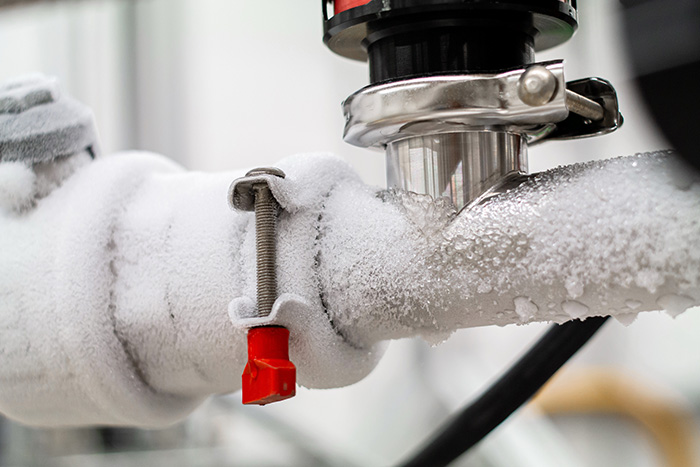Were you in search of insight on Helpful Tips to Prevent Frozen Pipes this Winter?

Winter can wreak havoc on your plumbing, particularly by freezing pipelines. Here's exactly how to prevent it from taking place and what to do if it does.
Introduction
As temperature levels decrease, the risk of icy pipes boosts, possibly causing costly repair services and water damages. Comprehending just how to prevent icy pipes is important for property owners in chilly climates.
Avoidance Tips
Shielding at risk pipes
Wrap pipelines in insulation sleeves or use warm tape to secure them from freezing temperatures. Focus on pipes in unheated or outside areas of the home.
Heating methods
Keep interior areas adequately heated, specifically locations with pipes. Open up cupboard doors to enable cozy air to flow around pipelines under sinks.
How to identify icy pipes
Try to find reduced water flow from taps, unusual smells or noises from pipelines, and noticeable frost on revealed pipes.
Long-Term Solutions
Structural changes
Consider rerouting pipes far from outside walls or unheated areas. Include added insulation to attic rooms, basements, and crawl spaces.
Updating insulation
Purchase top quality insulation for pipelines, attic rooms, and walls. Proper insulation aids preserve constant temperatures and reduces the danger of icy pipelines.
Safeguarding Outside Pipes
Yard tubes and outdoor faucets
Detach and drain pipes garden pipes prior to winter season. Mount frost-proof spigots or cover outdoor taps with insulated caps.
Understanding Frozen Pipes
What causes pipelines to ice up?
Pipelines freeze when subjected to temperatures listed below 32 ° F (0 ° C) for prolonged periods. As water inside the pipes freezes, it expands, taxing the pipeline walls and potentially triggering them to rupture.
Dangers and damages
Frozen pipelines can result in supply of water disturbances, property damage, and pricey repair services. Ruptured pipes can flood homes and trigger substantial architectural damage.
Indications of Frozen Water Lines
Determining icy pipelines early can prevent them from rupturing.
What to Do If Your Pipes Freeze
Immediate activities to take
If you believe frozen pipelines, keep faucets open up to alleviate stress as the ice thaws. Make use of a hairdryer or towels taken in warm water to thaw pipelines gradually.
Conclusion
Avoiding icy pipes requires positive measures and fast responses. By recognizing the reasons, indicators, and preventive measures, homeowners can protect their pipes during winter.
6 Proven Ways to Prevent Frozen Pipes and Protect Your Home
Disconnect and Drain Garden Hoses
Before winter arrives, start by disconnecting your garden hoses and draining any remaining water. Close the shut-off valves that supply outdoor hose bibs and leave the outdoor faucet open to allow any residual water to drain. For extra protection, consider using faucet covers throughout the colder months. It’s also important to drain water from any sprinkler supply lines following the manufacturer’s directions.
Insulate Exposed Pipes
Insulating your pipes is an effective way to prevent freezing. Pipe insulation is readily available at home improvement stores and is relatively inexpensive. Pay close attention to pipes in unheated areas such as the attic, basement, crawl spaces, or garage. Apply foam insulation generously to create a buffer against the cold. You can also wrap your pipes in heat tape or thermostat-controlled heat cables for added warmth.
Seal Air Leaks
Inspect your home for any cracks or openings that could let in cold air. Seal any holes around the piping in interior or exterior walls, as well as the sill plates where your home rests on its foundation. Additionally, make sure to keep your garage door closed unless you’re entering or exiting. Leaving it open creates a significant air leak that can lead to frozen pipes.
Allow Warm Air Circulation
During cold snaps, it’s essential to allow warm air to circulate evenly throughout your home. Leave interior doors ajar to promote better airflow. Open kitchen and bathroom cabinets to help distribute heat consistently around the rooms. If you have small children or pets, be sure to remove any household chemicals or potentially harmful cleaners from open cabinets for safety.
Let Faucets Drip
A small trickle of water can make a big difference in preventing ice formation inside your pipes. When temperatures drop significantly, start a drip of water from all faucets served by exposed pipes. This continuous flow helps prevent the water from freezing. Additionally, running a few faucets slightly can relieve pressure inside the pipes, reducing the chances of a rupture if the water inside does freeze.
https://choateshvac.com/6-proven-ways-to-prevent-frozen-pipes-and-protect-your-home/

Do you enjoy more info about How To Avoid Freezing Pipes? Put a review down below. We would be pleased to know your ideas about this write-up. We hope to see you back again before long. Appreciated our blog posting? Please quickly share it. Let somebody else find it. We thank you for your readership.
Give Me A Quote!